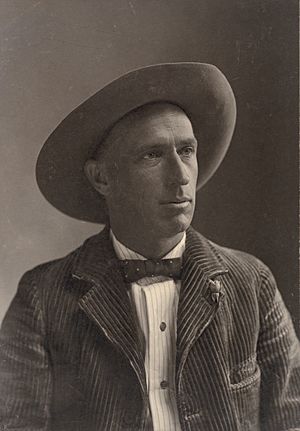The Land of Sunshine facts for kids

The cover of the August 1900 issue of The Land of Sunshine
|
|
| Former editors | Charles Dwight Willard Charles Fletcher Lummis Charles Amadon Moody C. F. Edholm George Wharton James Lannie Haynes Martin |
|---|---|
| Frequency | Monthly |
| Circulation | 10,766 (1903) 15,000 (1904, est.) |
| Founded | 1894 |
| First issue | June 1894 |
| Final issue | May 1923 (as Out West) July 1935 (as Overland Monthly and Out West Magazine) |
| Country | US |
| Based in | Los Angeles, California |
| Language | English |
| OCLC | 18724654 |
The Land of Sunshine was a popular magazine. It was published in Los Angeles, California, from 1894 to 1923. In 1902, its name changed to Out West.
Later, in 1923, it joined with another magazine called Overland Monthly. Together, they became Overland Monthly and Out West Magazine. This new magazine was published until 1935.
Many famous writers had their work published in The Land of Sunshine. These included John Muir and Jack London. The magazine was also known for its many beautiful pictures. These pictures helped show off the amazing things about Southern California. It helped make the area popular for tourists.
Contents
The Story of The Land of Sunshine
The Land of Sunshine first came out in June 1894. It was published by the F. A. Pattee Publishing Company. The magazine was quite large, about 9 by 12 inches.
At first, Charles Dwight Willard secretly edited the magazine. He was also the secretary for the Los Angeles Chamber of Commerce. The magazine supported businesses in Los Angeles and San Diego. Because of this, Willard kept his role a secret to avoid problems.
From the very beginning, the magazine tried to reach more readers. It asked people to share copies with friends. It also sent issues to libraries across the United States.
Charles Lummis Takes Over
At the end of 1894, Charles Fletcher Lummis became the official editor. His first issue was in January 1895. Lummis promised that the magazine would be "accurate" and "interesting." He wanted readers in the Eastern United States to trust what they read.
Lummis also focused more on culture and ideas in the magazine. The Los Angeles Times said he turned it into a "sterling literary magazine." He shared his strong opinions on many topics. He especially cared about the rights of Native Americans in the United States. He often criticized the government's policies towards them.
In June 1895, the magazine became smaller in size. It was now about 6 by 9 inches. However, it started to have more pages.
Expanding West and New Editors
In 1898, Lummis decided the magazine should cover the entire American West. He said the West was "far enough away from the East to be Out from Under." This idea led to the magazine changing its name to Out West in January 1902.
Lummis worked as the editor by himself until February 1903. Then, Charles Amadon Moody joined him. They worked together until Lummis left in November 1909. Many people believe that the magazine's fame started to fade after Lummis left.
After Lummis, several other people edited Out West. These included C. F. Edholm, George Wharton James, and Lannie Haynes Martin. After June 1917, the magazine stopped being published regularly. Finally, in May 1923, it merged with Overland Monthly. The new magazine, Overland Monthly and Out West Magazine, continued until July 1935.
How the Magazine Was Made
At first, The Land of Sunshine was printed by Kingsley-Barnes and Neuner Company. The pictures were made by different local companies. In 1898, the magazine started printing its own copies. They had special machines for printing both text and pictures.
The F. A. Pattee Publishing Company first published the magazine. But in August 1895, a new company took over. It was called the Land of Sunshine Publishing Co. Charles Lummis became the vice president of this new company.
How Many Copies Were Printed?
By December 1895, The Land of Sunshine printed 9,000 copies. The publishers said this was the most copies printed by any western monthly magazine. In July 1899, the average number of copies was 9,147.
The magazine printed the most copies in 1903 (10,766) and 1904 (about 15,000). After 1904, it became harder to know the exact number of copies. Estimates usually ranged from 7,500 to 12,500.
Most of the magazine's readers were in California. After that, many readers were in the Arizona Territory, New York, Massachusetts, and the New Mexico Territory. Even President Theodore Roosevelt was a subscriber! He told Lummis it was the only magazine he "took time to read."
Out West also had readers in other countries. In 1907, it had subscribers in England, Belgium, Italy, Germany, Japan, France, Sweden, Brazil, New Zealand, Mexico, Greece, Siam, and North China.
Writers and Artists

It was sometimes hard for The Land of Sunshine to find writers. This was because the magazine focused only on California and Western topics. Also, it couldn't always pay writers a lot of money. Charles Lummis himself often wrote a lot of the content. Sometimes, he even used fake names like C. Arloz or C. R. Lohs.
To get more writers, Lummis created a group of writers and artists. They were interested in Western stories. Instead of cash, he paid them with shares in the Land of Sunshine Publishing Co.
Some of the people in this group included George Parker Winship, Maynard Dixon, and Mary Hunter Austin. Grace Ellery Channing was also a very important writer for the magazine.
Charles Lummis wrote the most for the magazine. He contributed over 250 essays, articles, poems, and stories. Other frequent writers were W. E. Smythe and Sharlot Hall.
Besides editing and writing, Lummis also started two groups. The Landmarks Club worked to save old Spanish missions in California. The Southwest Society later became the Southwest Museum of the American Indian.



